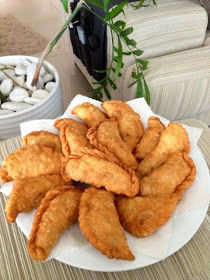Here it is my very first bold attempt making this traditional Chinese classic or zongzi in Mandarin, chang in Hokkien and dumpling in English. Frankly, I can't really believe that I have come this far making changs. What satisfies me the most is I went about doing everything on my own without the accompaniment of any experienced elder. I was all alone throughout the whole making process from buying the ingredients, cutting the meat, making the filling, tying the dumplings to boiling them. To tell you the truth, I've never bought pork from a butcher before and obviously
communicating with the not-so-friendly rough-spoken Chinese butcher in
Mandarin is quite a daunting task for me. I didn't even know what is pork belly called in Mandarin but luckily Google Translate saved the day.
Of course, I find wrapping and tying the dumplings the most challenging task. It all happened on a dark stormy night when rain was beating like bullets, lightnings were flashing rather frighteningly and thunders were booming angrily, I was all alone sitting in my living room wrapping and tying my dumplings. Hey, I'm not making up the whole scene okay but coincidentally this was what exactly happened that night.
After my wife and kids slept, I went downstairs, quickly set up my work station and began wrapping my dumplings accompanied by nobody except for a few virtual elderly aunties who appeared on my laptop screen showing me the way to wrap and tie the dumplings. While wrapping I was looking at the demonstration video clips via YouTube. Very true, it's easier seen than done! Immediately, I felt like giving up. The first dumpling I tied crashed down on the floor scattering all the grains and fillings. At that spur of the moment, my heart crushed and a surge of loneliness sipped in. While I was cleaning up the mess, suddenly I thought of my mom. How I wished she was beside me showing and guiding me how to tie dumplings. However, I went on to pick the bits and pieces of the grains including my crushed heart. Staying strong, I continued and and eventually pulled it through. I am now on my third batch of my dumpling making project. Yipee!
Okay, now back to my nyonya dumpling. I chose this recipe simply for the reason that it was Amy Beh's, a well-known celebrity chef and newspaper columnist in Malaysia. With her accolades, I thought how wrong could I go with her recipe? Browsing through the ingredients and after having a word with my tua ee (eldest auntie), YES I was on the right track. Based on my tua ee's input, I made slight modification to the recipe. I made it sligthly more flavourful after I was told that the taste would be blander during the boiling process.
Overall, I am absolutely glad that everything particularly the taste turned out well. I benchmarked it with my tua ee's dumplings and what I got was to me that of what I have been eating all these years. However, one setback, mine was not as nice-looking as that of my aunt's. Hers was clean-looking with a striking blue hue on top whereas mine was rather murky and not that appetizing. So, this leaves me with lots of rooms to improve.
Recipe - Nyonya Chang
Source : Kuali.com (Amy Beh)
Yields approximately 15 big dumplings
Ingredients

- 700g glutinous rice
- Some screwpine leaves, cut into 4 cm lengths
- Dried bamboo leaves, washed and boiled until soften
- Hemp strings for tying
- 2 tbsp salt
- 1 tbsp sugar
- 5 shallots, minced (I used 7 shallots)
- 2 tbsp chopped garlic
- ½ cup oil
- 3 tsp preserved soya bean paste (tau cheong)
- 7 tbsp coriander powder (ground ketumbar), mixed with 170ml water into a paste (increased to 8 tbsp)
- 450g belly pork, skin removed and cut into very small cubes
- 12-14 dried mushrooms, soaked and diced
- 100g candied winter melon, diced (increased to 150g)
- 3 tsp pepper
- 5½-6 tbsp sugar or to taste (replaced with brown sugar, 6-7 tbsp)
- 1 tbsp thick soy sauce (2 tbsp)
- 1 tbsp light soy sauce (2 tbsp)
- 2½-3 tsp salt or to taste
- ½ tsp ground black pepper

Method
To prepare rice (I apportioned the rice to tinged some blue with the blue pea flower)
- Boil some water together with 30 blue pea flowers to get blue tinged water.
- Soak 200g of the rice with this water for at least 3 hours.
- Soak the rest of the rice with water at the same time.
- Heat oil in a non-stick pan, fry shallots and garlic until aromatic. Add soya bean paste and coriander paste. Fry until fragrant.
- Add pork, winter melon and mushrooms, and mix in combined seasoning. Fry until pork is heated through. Dish out and set aside.
- Drain the glutinous rice and briefly rinse the rice.
- Overlap 2 bamboo leaves lengthways then fold into a cone.
- Fill in this order into the cone-2 tbsp blue glutinous rice, 2 tbsp filling, 2-3 tbsp white glutinous rice.
- Cover with a piece of screwpine leaf. Press down to compress the dumpling. Wrap into a pyramid shape. Tie tightly with hemp string to secure. Repeat until all the ingredients are used up.
- Bring a large pot of water to a boil. Add salt and sugar then put in the dumplings and immerse them completely. Cook in rapidly boiling water for 2-2½ hours. Remove the dumplings and hang them to drain off excess water.











